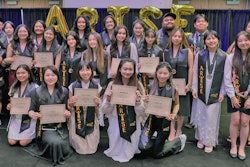Earlier this week, Cynthia Liu, a senior at the University of Wisconsin-Madison, was picking up her groceries at a supermarket near campus after class when another shopper asked her if she was from China.
When she told him “no”, but that her family was, he said, “‘Good, because if you are, I’m getting the f*** away from you.’” With a glance at her and another Asian student standing nearby, he ran off.
“We just stared at each other like, ‘What the heck just happened?’” Liu said. “We were just going about our day.”
Since a case of the coronavirus was confirmed in Wisconsin last week – a non-student who went to the university hospital for treatment – Liu said she’s seeing an increase in discrimination against Asian students on campus as well. Her classmates are avoiding Asian restaurants and steering clear of Asian students who wear masks, a “cultural thing” that began long before the coronavirus spread. Someone in the library made a disparaging remark about Chinese people to her friend from the Wuhan area, where the disease is centered, while she was talking to friends about her worries regarding her grandmother’s health.
This isn’t just a University of Wisconsin problem.
As the coronavirus spreads, with a majority of the over 40,000 cases in China, Asian international students and Asian American students are facing overt and covert discrimination on U.S. college campuses as their peers panic.
According to Dr. Russell Jeung, chair of the Asian American Studies department at San Francisco State University, the coronavirus isn’t the first time Asians have been the victims of health-related discrimination in the U.S. There are records – from the late 19th century and the early 20th century – of Chinese people deported for having smallpox and quarantined in San Francisco’s Chinatown during the spread of the Bubonic plague, he said. Chinese immigrants were also historically turned away from the U.S. because of supposed health concerns.
“Asian bodies have always been racialized to be seen as dangerous and threatening and disease-ridden,” he said.
So far, there have been at least 15 cases of the coronavirus in the U.S., including a number on college campuses like the University of Wisconsin-Madison, Arizona State University and the University of Massachusetts, Boston.
There have also been false alarms, like at the University of Southern California (USC). In late January, a supposed coronavirus case at a student apartment building near campus proved to be untrue.
At the time, Dr. Jonathan Wang, director of Asian Pacific American Services at USC, heard from Asian and Asian American students that they weren’t invited to social events, or got uncomfortable looks on campus. A couple of Chinese international students were told by their roommates that they shouldn’t live together anymore. The university quickly came out with health information and a “unifying message” of solidarity with Asian students.
Wang said the campus community had to ask itself, “How do we ensure we’re not preventing students from doing what they’re here for: to get an education?”
It’s a question a lot of campuses are struggling to answer as colleges across the country take measures to guard against the outbreak, quarantining students returning from China, canceling China study abroad programs and disseminating information about the coronavirus online and in campus forums.
While many of these efforts, like quarantines, are medically necessary, some run the risk of exacerbating racial profiling.
For example, the University of California Berkeley’s healthcare center made a controversial Instagram post, listing common reactions to the coronavirus scare, including “xenophobia: fears of interacting with those who might be from Asia and guilt about those feelings.” The post has since been deleted and the university issued a formal apology.
“It’s a clear example of normalizing xenophobia,” San Francisco State’s Jeung said. “That’s clearly the wrong message to send. It’s clearly offensive. And it’s clearly unhelpful.”
Instead of making students afraid of people who are sick, he wants to see universities cultivating “compassion” for students impacted by the disease, especially Chinese students who are afraid to travel home and who are worried about their families.
Campuses can do that by spreading clear, accurate health information, expressing solidarity with suffering students, helping quarantined students catch up on their coursework and supporting Asian cultural events, instead of curtailing or avoiding them.
The goal should be to “promote public health instead of community fear,” said Jeung. “We can use this opportunity as a time to build community.”
Alvin Camba, a sociology Ph.D. student at Johns Hopkins University, suggested schools make an effort to have mental health professionals for Asian students that look like them – and more counselors of color in general. On the metro in Washington D.C., a group of passengers shouted at Camba, telling him to go back to China. (He’s not Chinese.) He had never had an experience like that before.
For campus therapists, “it’s quite difficult to deal with issues you’ve never dealt with yourself,” Camba said.
As panic continues at the University of Wisconsin-Madison, for Liu, the most important thing is for universities to have clear communication with students to dispel misinformation and to encourage an understanding of what their fellow students are going through.
“I wish people would just be more empathetic towards each other,” she said. “I wish the response would be more supportive than it is.”
Sara Weissman can be reached at [email protected].



















